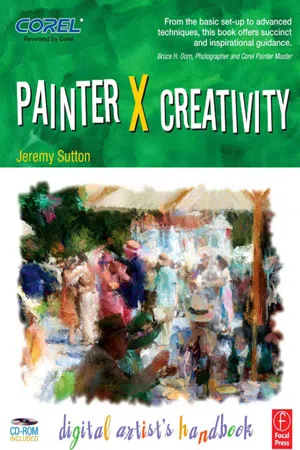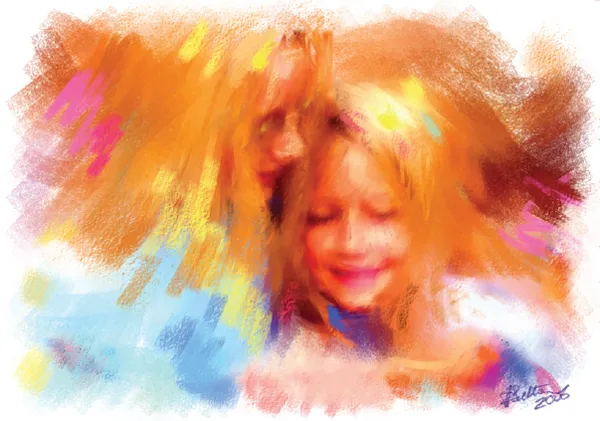![]()
1
Preparing
The preparation described in this chapter is designed to free you up to perform at your best and to fully realize your creative potential on the digital canvas.
An athlete makes sure they have good shoes and they stretch before running a race. A musician makes sure their instrument is tuned and warms up their hands and their instrument before performing. A speaker does a sound check, drinks water and clears their throat before talking on the podium. All three may take some quiet moments to relax and enter the mental state that will allow them to perform at peak potential. Likewise an artist needs to prepare their tools, mind and body to perform at their best. In thinking through what has helped me perform as an artist I have identified seven basic principles.
Seven Principles
1. Perseverance
The most powerful principle is also the simplest: to persevere. Be committed to your individual brush strokes and to persevering with your artwork, even when you feel like giving up. Albert Einstein (Figure 1.1) was an example of perseverance. In his words: “I know quite certainly that I myself have no special talent; curiosity, obsession and dogged endurance, combined with self-criticism have brought me to my ideas”.
Figure 1.1 “Contemplation—Portrait of Albert Einstein”, 1998, 31 inches × 36 inches.
My portrait of Ray Charles (Figure 1.2) went through several stages where it wasn’t working and I felt like giving up. I kept going and was pleased with the end result.
Figure 1.2 “Brother Ray”, 2005, 40 inches × 40 inches, showing a sequence of stages including the “ugly” second stage when I felt like giving up … The final stage can be seen in more detail in Chapter 6, Figure 6.1.
2. Passion
Paint with passion! Be true to yourself and your intuition.
When you paint from your heart it shows in the work and moves others. One of my students Linda Huddle-Martin, a professional portrait photographer from Pennsylvania tried an experiment: every time she made a commissioned portrait, she first made a version that she thought her clients would like and then made one for herself, more expressive and daring. She then showed her clients both versions and in every case they purchased the livelier version she did for herself.
We can draw inspiration from the passionate intensity with which Pablo Picasso (Figure 1.3) made art.
3. Respect
Respect yourself and your art. Make yourself comfortable and set up a healthy working environment. When you enter your painting studio (Figure 1.4) pause for a moment and prepare yourself for making the most of your creative space.
4. Serendipity
Serendipity is the accidental discovery of things. Embrace happy accidents and be open to the unexpected. This principle is a powerful tool in pushing your artwork to new levels of power and beauty. Welcome the unpredictable and uncontrollable artifacts of the creative process.
When a brush does something you don’t like or didn’t expect, don’t immediately dive for the Undo command, but see it instead as an opportunity to enrich your painting and explore directions you may not have previously considered. Improvize with whatever appears on your canvas. Each unexpected or unintended happening on your canvas is a little miracle that opens up new doors. With Painter’s vast array of brushes there are always surprises in store, and thus you won’t be short of little miracles in your paintings.
Figure 1.3 “Pain & Passion: Portrait of Pablo Picasso”, 1993, 38 inches × 56 inches, an early digital painting inspired by the Picasso’s passionate intensity.
5. Imperfection
We are often tempted to correct, delete or hide imperfections. Consider the opposite approach, one in which you appreciate imperfections.
Take a look at the beautiful rough sketch marks or loose brush strokes or visible corrections showing through in some of the finest works of art throughout history. Examples include Leonardo da Vinci’s unfinished masterpiece, the “Adoration of the Magi” (1481–1482, Uffizi Gallery, Florence, Italy), left in its yellow ocher and brown ink sketch phase, or Pablo Picasso’s seminal and powerful masterpiece, “Guernica” (1936, Museo Reina Sofia, Madrid, Spain), in which you can see his half-erased sketch marks revealing his compositional changes. Paradoxically it is often the imperfections, the marks of trial and error left visible, that vitalize and energize these paintings.
Figure 1.4 The view of my studio as I walk in.
Painting is problem solving. As you paint you continually resolve what is not working, trying out different solutions until the painting works. In non-digital painting every brush mark leaves its trace, even when you paint over or scrape off the paint. Every cycle of creation and destruction, of building up and breaking down, leaves its imprint and adds to the beauty of the end result. This applies whether you are using traditional or digital paint.
In the computer we are tempted by the instant Undo, which erases all traces of a brush stroke as if it had never existed. We tend to Undo anything we consider imperfect. I advise you to avoid the Undo command during your painting process. My painting, “Sisters” (Figure 1.5), is full of rough, imperfect brush strokes and has a sketchy background that I purposely left unfinished. The rough brush strokes serve as a counterbalance to the tender love between the two sisters.
Many cultures reflect this attitude of appreciating the imperfect. The renowned basket weavers of the Navajo Nation have a saying that “God is in the imperfections”. They always specifically include a subtle imperfection in their designs. The Japanese esthetic of Wabi-sabi finds beauty in the patina of aging and in the small details of everyday life that we so often overlook. It accepts the transience and impermanence of the world—that all things are in flux and are imperfect.
Figure 1.5 “Sisters”, 2006, 24 inches × 34 inches, showing imperfect brushwork and an unfinished background.
6. Improvization
Let go of the need to control and pre-determine every step of your journey. Allow yourself the freedom to improvize and respond spontaneously from moment to moment. Though you may start painting with a clear vision of starting from point A and ending up at point B, your path may take a turn you didn’t expect and lead you to a different destination than the one you originally envisaged (Figure 1.6). Be prepared to let anything go, to allow it to be transformed. Let intuition, spontaneity, improvization, and serendipity guide you.
This approach to creating is beautifully summed up by musician Loreena McKinnett in her liner notes for the album the Book of Secrets.
“In casting your inspirational net as an artist, you become familiar with the humility that comes with watching your best-laid plans veer sideways. So, you set out to travel to Rome … and end up in Istanbul. You set off for Japan … and you end up on a train across Siberia. The journey, not the destination, becomes a source of wonder.”
“In the end, I wonder if one of the most important steps on our journey is the one in which we throw away the map. In jettisoning the grids and brambles of our own preconceptions, perhaps we are better able to find the real secrets of each place.”
Figure 1.6 The development of “Say Hey, a Portrait of Willie Mays”, 2005, from an early stage (top) showing what was originally intended as the main anchor image, through to the final stage at (bottom), which can be seen in more detail in Chapter 7, Figure 7.23. Notice how I experimented with ideas and changed the composition.
7. Detachment
Detachment is useful if you find yourself struggling with a painting—it allows you to step back from attachment to the end result and gain clarity in the present moment. Conversely if you create a masterpiece that is widely acclaimed, allow yourself well-deserved sa...






